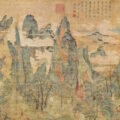Introducing Zhongshi Chen’s Modern Classic, White Deer Plain

The Dream of the Red Chamber, one of China’s four great classical novels, written in the middle of the eighteenth century by Cao Xueqin, records the decline and fall of two wealthy aristocratic clans in Beijing through a dream-like tale that revolves around the unpredictability and inconstancy of life. White Deer Plain, published in 1993, serves as a counterpoint to Red Chamber. Where the classical novel follows urban aristocrats, White Deer traces the vicissitudes of two wealthy farm families in Shaanxi; where Red Chamber is almost surreal, White Deer appears as realistic as a history book. Both books, though, see the world as a stage, and see those on stage demonstrating power over those beneath them.
White Deer Plain was written by Zhongshi Chen (1942-2016), a Chinese writer who grew up in rural Xi’an, Shaanxi province. Shaanxi has a long and rich cultural tradition. One of the cradles of Chinese civilization, it served as the capital for thirteen dynasties, beginning with the Zhou Dynasty in 1046 BC. Xi’an, the capital city of Shaanxi, is the eastern terminus of the ancient Silk Road to Europe and Africa. Chen was deeply rooted in his native land’s rich culture and tried throughout his career to paint a realistic picture of countryside life there. For White Deer Plain, Chen spent more than a decade researching the culture, history, and customs of his native Shaanxi. It took him another six years to complete. First published in 1993, it was the winner of 1997 Mao Dun Literature Prize, the highest literature prize for novelists in China, and was adapted into a popular film in 2011.
In the epigraph to the book Chen quotes Balzac, who believed that “the novel is no less than the secret history of nations.” Along the same lines, Friedrich Engels wrote, “I have learned more [from Balzac] than from all the professional historians, economists and statisticians put together.” Chen’s intention is hence revealed as clear as day: to tell the “secret” history of the nation, at least the rural part of China that he knew. To a significant extent, he has succeeded. In 2002, due to its ultra-realistic rendering of Chinese history, the novel was listed as one of the must-read for college students in China.
White Deer Plain is the story of two landowner families, Bai and Lu, over half a century and three generations, in a rural area called White Deer Plain, in Shaanxi, China. The story starts around 1900 and ends in the 1950s, the early years of the new Communist China. The characters witness all the major events that took place during that period of Chinese history, from the Revolution of 1911, which overthrew China’s last imperial dynasty, to the chaos of civil wars among warlords, the famine and plague, the first alliance between the Kuomintang (KMT) and the Chinese Communist Party (CCP) in the 1920s, the breakdown of that alliance, the Japanese invasion of China, the second alliance, the last civil war between the KMT and the CCP, and the final establishment of Communist rule in China.
Jiaxuan Bai, the protagonist and patriarch of the Bai family, is burdened with the urgent mission to produce a son, so that his family’s lineage would continue unbroken. When Jiaxuan’s father was dying, he asked his son to get married as soon as he passed away, instead of mourning for three years as the custom requires, because, as Confucian teaching goes, “Of the three unfilial conducts, the worst is to have no male descendant.” The book begins with the story of his seven marriages, one following the other in quick succession. The first six wives die without a single child. Jiaxuan stops with the seventh marriage when his wife at last gives birth to three sons and a daughter.
After that, Jiaxuan devoted himself to the care of the village shrine, the place of ancestral worship. He is steeped in Confucian teaching and follows it carefully in his daily conduct. When two of his sons reach school age, he started a school for all the village boys to attend. He is portrayed as a paragon of Confucianism: upstanding, morally uncompromised, flawless in his conduct, and widely respected in his village. He is famous for being a benevolent and righteous landowner, who treats his farmhand like a brother. But for all his efforts to offer a moral example to his children, his firstborn son commits adultery and conspires to send a good person to his death. And for all his benevolence, when his beloved daughter rebels against his patriarchal rule, Jiaxuan would rather see her die than break the marriage that he has arranged for her.
Xiaowen, the first-born of Jiaxuan, is one of the most provocative characters in the novel. During the year of famine, he sells his house and spends the money on opium with his mistress Xiao-er, Heiwa’s wife. As a result, his own wife—the mother of his two children—dies of starvation. Then Xiaowen is responsible for executing Heiwa before becoming a government official under the CCP rule as the head of their county.
Zilin Lu, the patriarch of the Lu family and counterpoint to Jiaxuan Bai, possesses an unbridled sexual appetite and has raped, among others, his own daughter-in-law. He is a villain, with no moral compass, who exhibits no redeeming characteristics and dies of senile dementia. In contrast to the Bais, both of Lu’s two sons turn out to be young men of noble character. Zhaopeng becomes an outstanding member of the CCP; Zhaohai becomes a party member of KMT who dies fighting the CCP.
The two wealthy families, Bai and Lu, battle openly and covertly, seeking dominance in the village. There is no class conflict in Chen’s novel. There are only good and evil landowners; good and evil persons in both political parties, KMT and CCP. The biggest conflicts are not between the haves and have-nots. The factor that differentiates people is not class, not economic status, but morality. Those who follow Confucian teachings, despite being landowners, are depicted as being good; those who deviate from these teachings appear irredeemably evil. In the end, however, the world under Chen’s pen is as senseless as “a tale told by an idiot.” Major events include the hired hand’s murder of his daughter-in-law, the rape and the death of Zilin’s daughter-in-law, the starvation and death of Xiaowen’s first wife in his father’s house, the death of Zhaohai when fighting communists, and the death of Ling Bai—Jiaxuan’s communist daughter—at the hand of her comrade.
White Deer Plain was written under the influence of at least three Chinese literary movements: literature of introspection, literature of the wounded, and root-searching literature.
Throughout the history of CCP, there have been numerous movements like the Yan’an Rectification Movement of 1942, Anti-rightist Movement of 1957, and Cultural Revolution of 1966-1976. During these periods thousands of innocent CCP members and other citizens were wrongly accused, persecuted, jailed, exiled, or executed. It is difficult to fathom the trauma and the psychological wounds wrought by the large-scale persecutions and senseless loss during these movements.
In 1980s, following the denouement of the Cultural Revolution and the start of the open door policy, as well as the loosening of party control, several new schools of literature came into fashion. Writers working in the literature of self-examination and the literature of the wounded, or scar literature, are critical, sometimes forcefully so, but often indirectly. They worked to denounce and expose the almost criminal chapters in CCP’s history, with the hope that history will not repeat itself. The writers of the wounded school in particular pour out their grievances and reveal the psychological and emotional wounds inflicted upon thousands of innocent people.
In this book, Bai’s only daughter, Ling, typifies those who met their tragic death at the hands of their comrades. Like thousands of young intellectuals at that time, Ling embraces the Marxist ideal of liberating the working class. With her youthful enthusiasm, she joins the communist party during the time of the so-called “white terror.” That is when KMT and CCP broke their first alliance, and KMT was desperately trying to wipe out the CCP. It was extremely dangerous for her to work as an underground communist in a KMT-occupied area (far more dangerous, to put this in context, than the French Resistance living under the Nazi occupation). After Ling survives the terror and travels to a region controlled by the CCP, she believes that she’s finally safe. But then, she is wrongly accused of being a KMT spy and brutally buried alive by her communist comrades during a CCP rectification movements. It seems almost absurd, but this was a common occurrence through the CCP’s history—a milder form of Stalin’s purges.
Following the end of the Cultural Revolution in 1978, leader Deng Xiaoping set in motion an unprecedented transformation of China’s economy by adopting an Open Door policy with the west. Before that, China, like pre-2015 Cuba, had only Russia and a few communist satellite states as trading partners. The open door not only ushered in goods and technology from Europe and the United States, it also allowed an influx of western ideas and literatures. Among western scholars, there was also renewed interest in Chinese culture, especially Confucianism. During the Cultural Revolution, Confucianism was considered feudal residue and thus repudiated. Many scholars and writers think it important to understand Chinese culture by going back to the roots, which is Confucianism. Against this background, a third literary movement called root-searching gradually took shape.
Chen wrote White Deer Plain and its protagonist, Jiaxuan Bai, in the image of Confucius teaching, examining China’s history and bearing witness to the victims of its violent past.
Despite the cultural and historical dimensions of this novel, literary work is first and foremost the story of deeply human experiences. Adultery, for instance, is as old as the institution of marriage itself. The transgression has been used as a means to achieve happiness, to break away from unhappy arrangements, or to defy a culturally defined role.
The adulteress in White Deer is Xiao-er Tian. She served as concubine for a man who was old enough to be her grandfather, whom she hated. Women at the time had few choices but to accept the place arranged for her by her family. Desperately unhappy, she has an affair with Heiwa, the young hired hand of the family. Before long, it’s discovered by her husband. Heiwa is sent away and Xiao-er is sent home with the greatest disgrace. Later, Heiwa finds out where Xiao-er lives. He goes to her house to ask for her hand and is instantly granted permission— Xiao-er’s family could not wait to get rid of her.
Heiwa takes Xiao-er back to his village, but she’s denied the honor of worshipping ancestors at the village shrine. Later both are expelled from Heiwa’s family. She’s shunned by decent folks. Heiwa participates in land reform organized by the CCP but has to flee the village when KMT take control. During Heiwa’s absence, Xiao-er is sexually exploited, with the promise of helping her get back to her husband. She’s used to seduce Xiaowen in order to ruin Jiaxuan. Xiao-er is then stabbed her to death.
A tragic figure like Xiao-er recalls such figures as Anna Karenina and Madame Bovary. As usual, the men come out of adultery unscathed, and women’s inferior social status in China at the time is clearly described throughout the novel.
Marriage plays a central role in Confucian culture. Jiaxuan, as an orthodox man, views family as an instrument to bear sons to carry on family lineage; it is not the place for romantic love. A decent man is not supposed to enjoy sex. He is supposed to use it for reproductive purpose. Confucian teachings prioritize filial duty, parental care, respect between couples, brotherly love, and benevolence—but never romantic love, which is why Chen’s novel abounds with descriptions of loveless sex and why Jiaxuan seems to have no memory of his six deceased wives aside from his sexual encounters with them.
There’s nothing unique about Confucianism’s view on sex and romantic love. By comparison, the Confucian attitude toward sex is akin to Catholic celibacy, though perhaps more humane: celibacy would break the Confucian family line, and family is regarded as the indispensable social group in Confucian culture. Like many religious ideologies, Confucianism was formulated, primarily by men, with a significant skepticism about romantic love—maybe for fear of succumbing to it.
When Ling Bai refuses the loveless marriage that her father arranged for her, Jiaxuan considers this an unpardonable sin. He would rather see her die than face the shame of it. So he locks his own daughter inside a house and plans to starve her to death. The hypocrisy in Confucian culture is that society finds no fault with a rich old man who indulges himself in loveless sex with as many wives as he can afford, young and pretty, but it turns and condemns a young women like Ling and Xiao-er. Confucianism generates a not-so-“secret history” of sexual perverts like Xiaowen, Zilin Lu, and even Xiao-er ex-husband.
The period depicted in White Deer Plain includes fighting among warlords, between the CCP and KMT, against Japanese invasion, and inside the CCP. Chen’s novel is a miniature of China, a grand opera set on a village stage. All of the events therein can be found elsewhere in the country. Toward the end of the book, Heiwa is executed. To me, the death of this kind-hearted prodigal son at the hand of Xiaowen reaches the height of absurdity. It seems to be the author saying clearly: there is no meaning in experience; nothing matters as much as being alive, watching events unfold, like watching folk operas on the stage of White Deer Plain.
About Yanwen Xia
Yanwen Xia, PhD, is a researcher at the University of Kansas Cancer Center.





